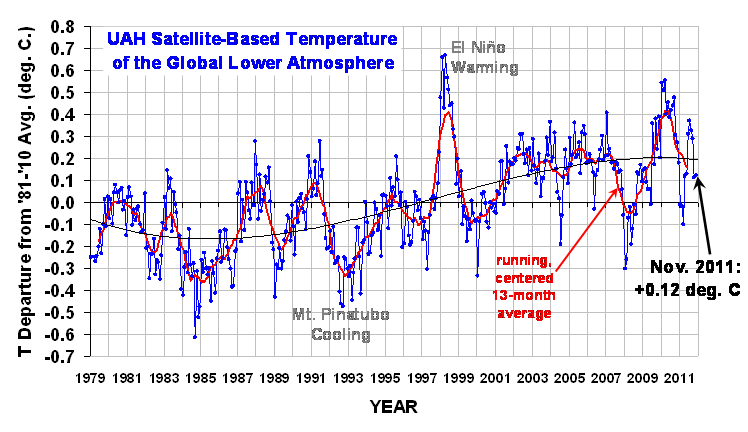The global average lower tropospheric temperature anomaly for November, 2011 remained about the same as last month, at +0.12 deg. C (click on the image for the full-size version):

The 3rd order polynomial fit to the data (courtesy of Excel) is for entertainment purposes only, and should not be construed as having any predictive value whatsoever.
Here are this year’s monthly stats:
YR MON GLOBAL NH SH TROPICS
2011 1 -0.010 -0.055 0.036 -0.372
2011 2 -0.020 -0.042 0.002 -0.348
2011 3 -0.101 -0.073 -0.128 -0.342
2011 4 +0.117 +0.195 +0.039 -0.229
2011 5 +0.133 +0.145 +0.121 -0.043
2011 6 +0.315 +0.379 +0.250 +0.233
2011 7 +0.374 +0.344 +0.404 +0.204
2011 8 +0.327 +0.321 +0.332 +0.155
2011 9 +0.289 +0.304 +0.274 +0.178
2011 10 +0.116 +0.169 +0.062 -0.054
2011 11 +0.123 +0.075 +0.170 +0.024
Since last month I predicted another temperature fall for November, which did not occur, I will admit that I should have followed my own advice: don’t try predicting the future based upon the daily temperature updates posted at the Discover website.
FYI, I’m making progress on the Version 6 of the global temperature dataset, and it looks like the new diurnal drift correction method is working.
[Reminder: Since AMSR-E failed in early October, there will be no more sea surface temperature updates from that instrument.]

 Home/Blog
Home/Blog



